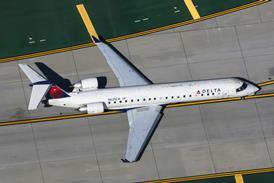GUY NORRIS / MOJAVE
General Electric's flight test team had to learn new techniques to knock the rough edges off the the world's most powerful jet engine, the GE90-115B.
Cruising high over the Rocky Mountains in GE's Boeing 747 flying testbed, it is easy to see why the GE90-115B is far and away the most powerful jet engine ever built. Mounted on the No 2 inboard engine pylon, the enormous powerplant easily pushes us along at around 250kt (460km/h), while the throttles of the remaining three engines are well back, barely above flight idle.
Testing such a large, powerful engine brings unique challenges to the California-based flight test team. The inlet is itself 3.25m (128in) in diameter, and the huge fan-set seems more reminiscent of a power station turbine or a tunnel excavator than an aero-engine. Encased in its impressive nacelle, the powerplant seems to shrink the 747 and is proportionately similar to the CFM56 on the 737. To keep the aircraft balanced, the 747's starboard wing tanks are permanently ballasted with 10,440kg (23,000lb) more fuel than those in the port wing on which the GE90 is suspended.
Then there is the piloting challenge of how to safely test the engine, which is being developed exclusively for Boeing's long-range 777-200LR and -300ER ultra long-range twins. The engine's 115,000lb (512kN) take-off thrust rating is almost equal to the combined power of all three of the testbed's Pratt & Whitney JT9Ds, requiring a delicate balancing act on the throttles during all phases from taxiing to landing. The engine's huge bulk clears the ground by a scant 0.3m (1ft), requiring extra care when landing with any cross-wind component.
Describing a typical throttle-juggling take-off in the 747, chief test pilot Phil Schultz says: "You have so much thrust it can overpower the nosewheel steering in a heartbeat. You have to discipline yourself to move the nosewheel steering by only an inch or two - otherwise you're off the runway in three heartbeats." Schultz says the balancing act is made more difficult because "you are not only trying to keep the thrust moment equal as you accelerate, but you also have to have some pilot control to steer with."
For take-off the co-pilot sets the No 2 (test engine) throttle, while the flight engineer advances 3 and 4. At brake release, No 1 is slightly above idle at around 20% power.
Precision is paramount
The pilot steers with the nosewheel and, by adding or reducing thrust with No 1, accelerates through 80kt, at which time the rudder becomes effective. At this stage, No 1 is pushed up to 78% power. "If you go beyond that it would go off the side of the runway, and if you had a failure in No 4 you'd be off even quicker," says Schultz. "If you have less than 78% on No 1, and No 2 fails, then you'd be off the left side of the runway."
Once airborne, the pilot needs full rudder deflection to keep the aircraft straight, while V2 speed is held until 1,500ft is reached and the 747 is levelled off. Moving quickly before the sheer combined power of the engines threaten to accelerate the 747 past its maximum flap speeds, the flaps are brought up. "As the flaps come up, we bring No 1 and No 3 back to idle. Then we deploy full speed brakes and come to 250kt while modulating No 4 to control speed," says Schultz. With No 4 generally left in the 50% thrust position, the pilot can relax the rudder pressure and maintain full rudder trim.
Since the engine tests necessarily involve rapid thrust changes, the crew have become adept at running through much of the equivalent of the take-off and climb procedure in a few seconds. "We go from a trim condition of full left to full right every time we do a throttle transient," says Schultz.
Against the complex backdrop of managing the testbed, tests on the actual engine have produced better than expected results, particularly compared with the problems experienced during the original GE90 flight test effort in 1994. "So far it's terrific, and we were at the same point after one test flight on this programme that we were after 20 on the base programme," Schultz says.
Despite the considerable differences between the smaller GE90 series and the -115B, the relatively trouble-free performance of the test engine is largely attributed to its derivative pedigree and well-tested new hardware and software. "Things like fuel nozzles were correct first time. The control guys were able to implement everything and make it good from the start," Schultz says. The testbed itself has also been thoroughly upgraded, and the sophisticated on-board systems allow more engine and control system adjustments in flight.
New fan design
The improved performance of the engine itself is strongly linked to the new fan design which test director Al Krejmas says provides significantly more flow to the core: "On one early test flight, we performed a successful air start at 39,000ft, which was the first since the J79. We have never had a commercial engine do that." He adds: "We planned to do one at 41,000ft, but we couldn't flame it out to start with." The massive fan, constructed of the same composite material as the original GE90 series, is 130mm (5.1in) larger in diameter, and exhibits more sweep than its predecessor. To deal with the increased core flow, the -115B has one additional low pressure (LP) compressor stage - an added benefit of a reduced exhaust gas temperature (EGT).
The higher flow also drives other changes further back in the core, including de-staging of the high pressure (HP) compressor and fewer LP turbine stator blades, a configuration GE calls low solidity LPT airfoils. With painful memories of the original GE90 development programme still resonant, GE has ensured that all changes to the bigger engine are low-risk from the outset. Any feature that is not already a simple evolution of the current GE90 was thoroughly tested and matured before the detailed design phase. This includes the swept fan, the de-staged HP compressor and the revised LP turbine, as well as two other innovations: a load reduction device to de-couple the fan in case of failure, and new material for the fan mid-shaft. The load reduction device has enabled weight to be saved throughout the engine and its support structure, while the new mid-shaft fan alloy has ensured it can cope with the higher torque loads while staying within the current core envelope.
Following the success of the advanced three-dimensional (3D) aerodynamics technology in the HP compressor, introduced in the -94B version, GE also cascaded the same design advance into the HP turbine of the -115B. The 3D changes in the compressor and turbine bring significant improvements in efficiency, helping to reduce fuel consumption as well as EGT. The HP compressor also features a blisk stage while, aft of the combustor. The HP and LP turbine flow functions have been increased without changes to the pre-existing flowpath.
Final tests on most of the key -115B features were completed in mid-2000. This marked GE's "toll gate 6" milestone, the company's traditional trigger point for allowing the start of design release. This duly occurred in August of that year. In November 2001, the first of nine test engines in the certification programme was fired up at the company's Peebles test site in Ohio and on its second run, it reached a world-record thrust level of 123,000lb. Five of the test engines are conducting endurance-related work as well as other tasks such as performance mapping, fan/compressor stress tests, cross-wind characteristics, icing, hailstorm and operability. Others are tasked with service readiness work, emissions measurement, bird strike and blade out, water ingestion, acoustics, and HP compressor and turbine stress certification. The water ingestion test, which was completed by the end of September, involved pumping 4,170litres (1,100USgal) or around 4.5t/min into the engine for 30s.
Engine 906-004 is mounted on the flying testbed while a further two shipsets of compliance engines are at Boeing for flight tests on the 777-300ER. For the first time GE is also directly involved with US Federal Aviation Administration FAR 25 aircraft certification as well as FAR 33 powerplant approval, and some 777 test pilots have had the chance to handle the engine first hand on some 747 flights.
Certification, originally planned for the end of December, is not now expected until January after evidence of thermal distress was found in the platform area of the first stage HP turbine on the triple redline 150h block test and endurance engine -006. GE says borescope inspections revealed the problem after around 35h of tests, and the block test is expected to resume in early December following modifications to the cooling air-routing to the area around the base of the blades. "A real engine can't run in these conditions, so it is not what we'd see as a show stopper," says GE90 general manager Chaker Chahrour.
Performance testing
Flight tests on the 747 are meanwhile expected to be completed by the end of December after the completion of around 30 flights and 150h, not including a further 60 or more hours of planned engine-related 777-300ER tests. The objective of the 747 tests was to demonstrate the full altitude capability of the -115B and iron out any unexpected flaws or undetected control issues. Performance in terms of specific fuel consumption and EGT has been tested at both steady state and transient conditions, covering the full power spectrum from take-off and climb to cruise.
Operability was tested with bursts, chops and bodies, with none of the surge problems encountered on the first engine recurring. The control system was also optimised, with real-time adjustments made to the third generation full authority digital engine control (FADEC) software logic, as well as to the variable bleed valves, stator vanes and active clearance control features.
By late November, more than 85% of the engine certification tests were finished, with over 1,500h and 3,500 cycles completed. Icing, fan stability and overspeed, LP turbine overspeed, HP and LP rotor vibration endurance, hailstorm, hailstone, ice slab and emissions tests have been carried out, and preparations are in hand for the full engine blade-out test on 7 December, following a successful rig test at Alston in the UK.
Results to date are encouraging, says Chahrour. Thrust at fan speed is more than 1% higher than predicted, and in terms of specific fuel consumption, "we have demonstrated about 5% better than the book performance." The EGT margin, as demonstrated over 3,000h, is "about equal to 20,000h on wing, so that's better than our customer specifications."
Marketing recovery
GE hopes the good start will help boost the marketing effort which, after two years in apparent stasis, recently showed signs of life with a new order from Pakistan International Airlines for two 777-200LRs and three -300ERs. Although only 50 long-range aircraft and around 110 engines have been sold so far, GE hopes that a market revival will be under way by the time the first aircraft enters service in April 2004, and that the planned target of 500 aircraft and 1,100 engines will not only be achievable but prove conservative.
Source: Flight International























